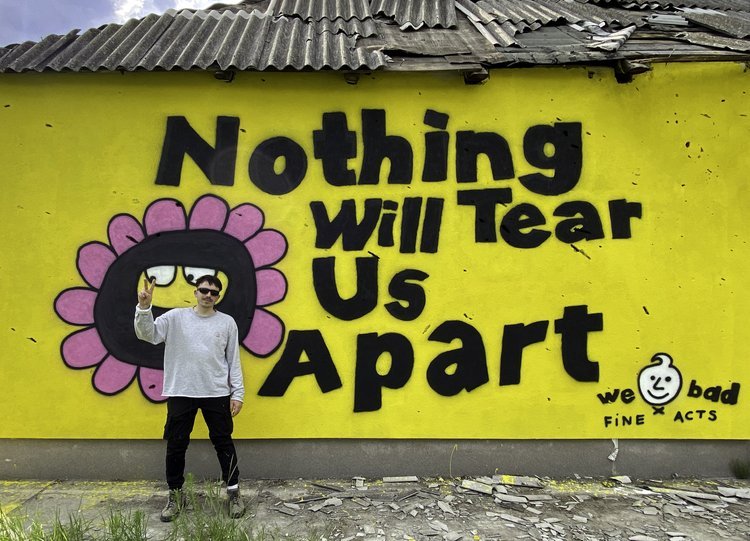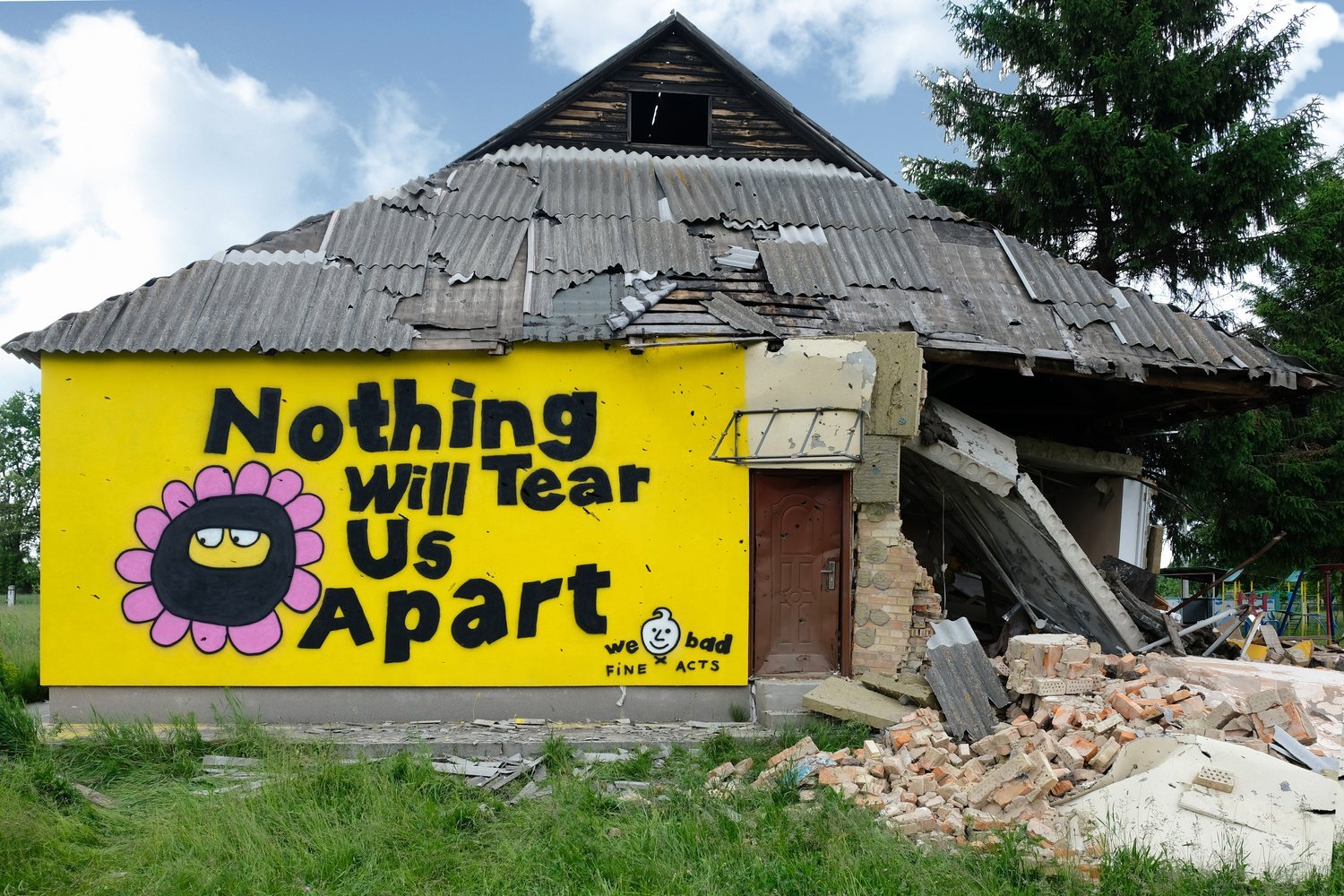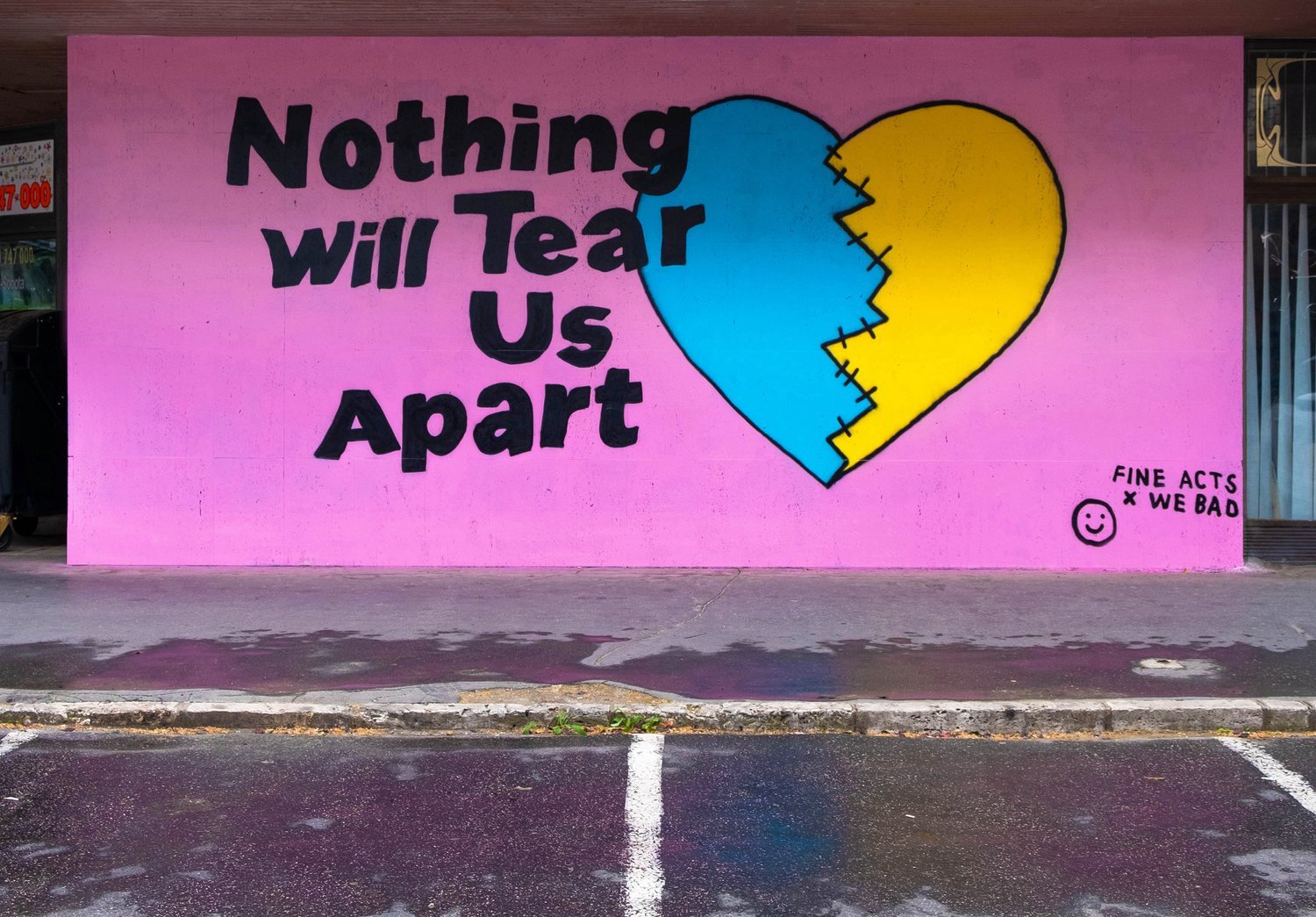Shortly after the start of the war in Ukraine, we reached out to our friends at Kyiv-based artist duo WE BAD with an invitation to collaborate on a mural project in Ukraine on strength and hope. But they had a better idea. Separated by the war, the artists – Lera Sxemka and Maxim Pavlyuk – wanted to keep working together, and suggested creating two murals – one close to Kyiv, Ukraine, and the other in Kosice, Slovakia.
“To escape the missiles and bombs, we left Kyiv. And after two weeks, we made a very painful decision: Lera would go to a safe place abroad, to continue working, and Maxim would come back to Kyiv, to be helpful there. We broke apart, the same as thousands of families around the country. […] We’ve always done everything together – and although we are divided by a thousand kilometers, it was crucial to us to continue creating together”, say the artists.
So for our collaboration with WE BAD, Maxim created a mural on the walls of a bombed kindergarten in the Ozero village, Kyiv region, while Lera worked on one on a local government building in Kosice, Slovakia – to give hope to the millions of Ukrainians who find themselves outside their home, and to those on the front. Preview the two works here.
We interviewed Lera and Maxim about the murals they created, their work process, and what the role of art & the artist community has been since the start of the war in Ukraine.
The mural project is part of a series of creative collaborations with a bunch of Ukrainian artists we love: beingukraine.org.
What is the role of art in war?
Lera: In our world today, war is not only fought on the battlefield, but also in the media. So, art has become an important instrument of resistance and communication. Art is a universal language that is now our weapon in the struggle for freedom and independence.
Maxim: I think the role is not big, unfortunately. It’s all about drawing the world's attention to the situation.
Why was it important for you to create together, even when apart?
L: Parting was painful and hard. I felt like a torn leaf. And I also feel that thousands of people are going through the same thing right now. WE BAD is our kid – it’s the result of many years of learning and work. And we are not ready to give it up.
M: Because we enjoy it.
Tell us a little bit about each work and how they work together?
L: We wanted to create something simple and easy-to-understand by different people. Something that can work separately and together. This message reminds people that they are not going through this hell alone, that good always triumphs over evil, and that we’ll meet everyone we love soon.
M: I think everyone will understand what it’s about. The question is if they realize?
What was the process of finding the locations like? Why did you pick those buildings for the murals?
L: For me it was important to create it in a nice, calm central area in the city, where people just live their normal happy lives. Because that was the most shocking moment after crossing the border of Ukraine. I couldn’t understand how life could be so different just across the border.
A couple of years ago we took part in an artist residency programme, organized by Street Art Communication, a local organization that works with street art in Kosice, Slovakia. We became good friends and these guys helped us with finding the wall for the second mural and getting permission. The building is in the historical part of the city and hosts local authorities. From the first days of war, this building was the spot where support services were offered to Ukrainian refugees, including food and clothing.
M: I must say that I’ve been to this place many times before, and I was shocked to see this beautiful city and its streets, buildings, cars, cafes and other places destroyed. I was horrified at how this can happen in the 21st century. And at the same time on Instagram, I see how life is continuing as usual – people hanging out in Berlin, for example.
I picked a kindergarten. Childhood is the most free, defenseless and happy age, and now it’s taken by sick adults. In this case, the kindergarten is a message to adults – how crippled and inhuman they can be.
What is your message as artists? What do these works mean to you?
L: Good always triumphs over evil. We are a brave nation and we are going to fight for what we love.
M: I want people to pay attention to this war in a European country and think about the lives of millions of Ukrainians, and at this point also about their own lives. I want people to reconsider their values.
How is the artist community in Ukraine and beyond resisting the war, and supporting people within the country?
L: Since the war started, people in Ukraine have united as a family. After the initial shock passed, the artist community activated in an amazing way. Designers, illustrators and artists started to create NFT, sell artworks, and document the history of the war to raise money for our defenders.
M: Everyone rallied and works to help Ukraine.
How has the war affected you – personally, creatively?
L: I feel empty and tired. Values have changed. Many things that used to be important are not anymore.
M: It changed my views on many things.
What do you hope for?
L: All my hopes and beliefs are about our speedy victory. Each day I wake up and before checking the news, I hope that I don’t see information about new civilian and children’s deaths. My hopes are about expelling the Russian army from my lovely native Kherson, so I can finally see my family and not worry about them like crazy.
M: I don’t have any hopes, I just strongly believe in our victory.




